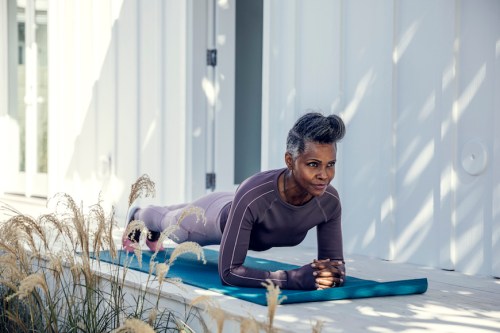Planks are Good for Your Heart, Too—Here’s How to Increase Their Cardio Cred
We know they strengthen the core, but are planks cardio? Here's how to tell if you're getting heart health benefits from your plank.

Planks aren’t usually associated with heart health. This classic exercise—which involves holding yourself in a push-up position for, like, ever—is generally seen as a strength-training move for the core, back, arms, and glutes. Sure, planks are hard AF… but they’re not cardio, right?
Experts in This Article
Ana Snyder has an MS in exercise physiology from Cal State. She’s a fitness coach, model, and entrepreneur who’s written numerous articles, worked with prestigious brands, and trained several high-level executives in physical activity, nutrition, and the science of exercise.
New York City-based cardiologist and founder of Upper East Side Cardiology
As it turns out, planks can tune up our tickers, making them advantageous for overall body strength and endurance. Satjit Bhusri, MD, a cardiologist and founder of Upper East Side Cardiology, explains that the seemingly simple act of holding up your body weight helps strengthen your heart by diverting blood to the muscles that need the energy. The longer you hold a plank—at least 60 seconds, ideally—the harder your heart works to send your muscles the oxygenated blood they require.
If you want to know for sure whether your planks are giving you cardio benefits, turn on your fitness tracker—you’ll want to take note of your heart beats per minute (BPM) to get into your optimal heart rate zone for increasing cardiovascular health, says Dr. Bhusri.
According to the American Heart Association, your maximum heart rate is about 220 minus your age. Your target heart rate while doing moderate activities is 50-70 percent of your maximum heart rate. To crunch that number, take the first number (220 minus your age) and multiply it by the percentage. So, if you’re 30 years old, your target heart rate at 55 percent should land at about 101 BPM—that’s where you’ll see the best cardiovascular results while doing a plank. (If all that math is too complicated, check out this handy chart by the AHA.)
If your heart rate in plank isn’t as high as you want it, consider adding some simple movement to your plank routine. “It’s important to remember that cardiovascular endurance and muscular endurance are two separate things,” says certified personal trainer Ana Snyder, M.S. “Stationary planks can help with cardiovascular endurance to some extent, since your heart rate will elevate, but moving planks get your heart rate up higher and are more effective for heart health.”
Need some ideas? Snyder has you covered. Below are 4 fun ways to ensure your planks are cardio friendly:
Plank jacks
Start in a high plank position on your hands and toes, with your spine aligned down to your ankles. Then, jump your feet out and in (like you’re doing jumping jacks) while keeping your core engaged and your hips level.
Knee-to-elbows
In the same high plank position, bring your left knee in towards your left elbow, then repeat on the right side. Alternate back and forth as quickly as you can without losing form.
Plank walks
While in your plank, walk your hands and feet sideways for 10 steps. Then walk back to the other side. Repeat for 30 seconds to 1 minute.
See-Saw Planks:
Start in a low plank position on your forearms and toes, with your spine aligned down to your ankles. From there, squeeze your abs and use your toes to push yourself forward and then pull yourself backward in a sawing motion. Repeat the movement several times until you reach the 60-second mark (or you feel your form slipping.)
Whether it’s a stationary or moving plank, Snyder reminds you to breathe—something that’s tough to do while using all of your core muscles to hold yourself up in that plank position, but is oh-so-necessary for a heart-rate boost with benefits.
Sign Up for Our Daily Newsletter
Get all the latest in wellness, trends, food, fitness, beauty, and more delivered right to your inbox.
Got it, you've been added to our email list.










